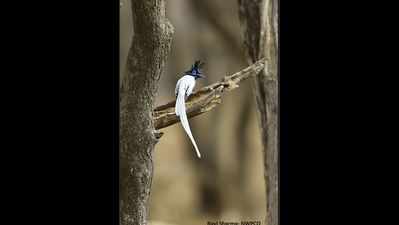- News
- City News
- indore News
- Young Indian paradise flycatcher finding it difficult to survive?
Trending
This story is from July 26, 2016
Young Indian paradise flycatcher finding it difficult to survive?
The number of Indian paradise flycatcher of older age nesting in Indore region has witnessed a rise this year indicating that the death rate of the younger state bird has increased, claims a study conducted by nature and wildlife protection and conservation organization (NWPCO).

INDORE: The number of Indian paradise flycatcher of older age nesting in Indore region has witnessed a rise this year indicating that the death rate of the younger state bird has increased, claims a study conducted by nature and wildlife protection and conservation organization (NWPCO).
NWPCO president Ravi Sharma said that they had been studying the nature of birds for past few years and they have noticed drastic changes in the nesting population of the state bird this year.“Till last year only one or two old male flycatcher birds were seen nesting in the area. Surprisingly, this year at least eight of them were spotted nesting,” said Sharma
He informed that they have collected a data on nesting of the flycatcher from different areas like Manpur, Kajligarh, Tincha and Mehandikund. The birds come for breeding in the area and the less number of young birds’ nests suggests that there are chances that the younger birds are finding it difficult to survive. “It might be possible that the mortality rate is increasing, as the number of young birds has reduced giving an opportunity for nesting to the older birds,” Sharma said.
Meanwhile, he also said that it would be too early to come to a conclusion. The behavior and the reason behind the decline are required to be studied. Another bird expert said that it is difficult to prove that their number is decreasing and further studies need to be carried on.
This particular species of bird breeds in the forested areas near Indore in the month of June-July with the arrival of monsoon. Damp weather makes the forest abundant with insects, which is the primary diet of these insectivores' birds. They come here to breed as they have plenty of food available. The pairs had already laid eggs. By the end of July, they would be seen feeding their babies. One cannot distinguish between a female and a male flycatcher in young stage by colour. The upper part of both of them is of rufous color. However, when the male grow old they turn into white colour.
NWPCO president Ravi Sharma said that they had been studying the nature of birds for past few years and they have noticed drastic changes in the nesting population of the state bird this year.“Till last year only one or two old male flycatcher birds were seen nesting in the area. Surprisingly, this year at least eight of them were spotted nesting,” said Sharma
He informed that they have collected a data on nesting of the flycatcher from different areas like Manpur, Kajligarh, Tincha and Mehandikund. The birds come for breeding in the area and the less number of young birds’ nests suggests that there are chances that the younger birds are finding it difficult to survive. “It might be possible that the mortality rate is increasing, as the number of young birds has reduced giving an opportunity for nesting to the older birds,” Sharma said.
Meanwhile, he also said that it would be too early to come to a conclusion. The behavior and the reason behind the decline are required to be studied. Another bird expert said that it is difficult to prove that their number is decreasing and further studies need to be carried on.
TOI has earlier reported that the number of nests of the birds in the Kajligarh forest was less than previous year. A lot of human intervention has led to a destruction of the natural habitat of the state bird in Kajligarh and other forest areas, where they are found.
This particular species of bird breeds in the forested areas near Indore in the month of June-July with the arrival of monsoon. Damp weather makes the forest abundant with insects, which is the primary diet of these insectivores' birds. They come here to breed as they have plenty of food available. The pairs had already laid eggs. By the end of July, they would be seen feeding their babies. One cannot distinguish between a female and a male flycatcher in young stage by colour. The upper part of both of them is of rufous color. However, when the male grow old they turn into white colour.
End of Article
FOLLOW US ON SOCIAL MEDIA










